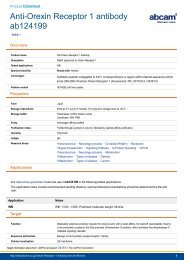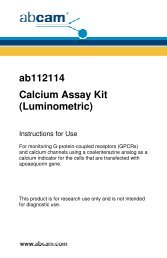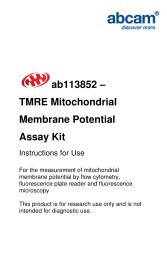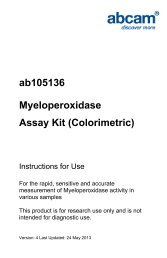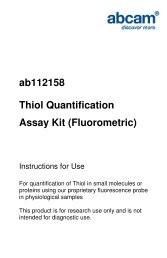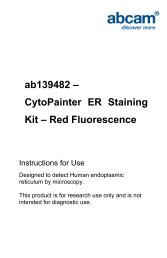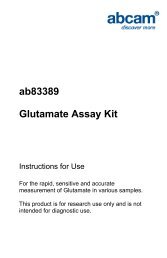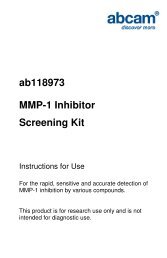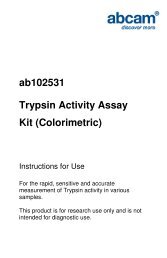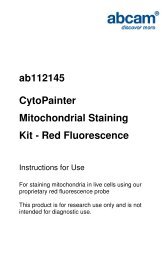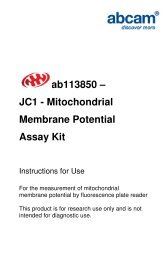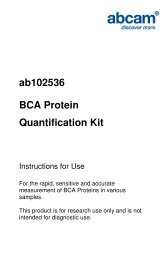You also want an ePaper? Increase the reach of your titles
YUMPU automatically turns print PDFs into web optimized ePapers that Google loves.
<strong>ab83464</strong><strong>Catalase</strong> <strong>Assay</strong> <strong>Kit</strong>Instructions for UseFor the rapid, sensitive and accuratemeasurement of <strong>Catalase</strong> activity in varioussamples.This product is for research use only and is notintended for diagnostic use.
Table of Contents1. Overview 32. Protocol Summary 33. Components and Storage 44. <strong>Assay</strong> Protocol 65. Data Analysis 96. Troubleshooting 112
1. Overview<strong>Catalase</strong> (EC 1.11.1.6) is a ubiquitous antioxidant enzyme that ispresent in nearly all living organisms. It functions to catalyze thedecomposition of hydrogen peroxide (H 2 O 2 ) to water and oxygen.<strong>Abcam</strong>’s <strong>Catalase</strong> <strong>Assay</strong> <strong>Kit</strong> provides a highly sensitive, simple,direct and HTS-ready assay for measuring <strong>Catalase</strong> activity inbiological samples. In the assay, catalase first reacts with H 2 O 2 toproduce water and oxygen, the unconverted H 2 O 2 reacts withOxiRed probe to produce a product, which can be measured at570 nm (Colorimetric method) or at Ex/Em=535/587nm (fluorometricmethod). <strong>Catalase</strong> activity is reversely proportional to the signal. Thekit detects high pico-unit of catalase in samples.2. Protocol SummarySample and Positive Control PreparationH 2 O 2 Standard Curve PreparationAdd H 2 O 2AAdd Develop MixMeasure Optical Density3
3. Components and StorageA. <strong>Kit</strong> ComponentsItemQuantity<strong>Catalase</strong> <strong>Assay</strong> Buffer25 mLOxiRed Probe (in DMSO) 200 µLHRP1 vialH 2 O 2 (3%; 0.88M) 25 µLStop Solution1 mL<strong>Catalase</strong> Positive Control1 vial* Store the kit at -20°C, protect from light.Warm the <strong>Assay</strong> Buffer to room temperature before use.Briefly centrifuge vials before opening.Keep samples, HRP and <strong>Catalase</strong> on ice during the assay.All these components are stable for 2 weeks at 4°C or for1 month at -20°C after reconstitution.4
Read the entire protocol before performing the assay.OxiRed PROBE: Briefly warm at 37°C for 1-2 min tocompletely melt the DMSO solution. Store at – 20°C, protectedfrom light. Use within two months.HRP SOLUTION: Dissolve with 220 μl <strong>Assay</strong> Buffer; it issufficient for 100 assays.POSITIVE CONTROL SOLUTION: Dissolve positive control vialinto 500 μl <strong>Assay</strong> Buffer. Aliquot 100 μl per vial, store at -20°C.B. Additional Materials RequiredMicrocentrifugePipettes and pipette tipsFluorescent or colorimetric microplate reader96 well plateOrbital shaker5
4. <strong>Assay</strong> Protocol1. Sample and Positive Control Preparations:a) Homogenize 0.1 gram tissues, or 10 6 Cells, or 0.2 mlErythrocytes on ice in 0.2 ml cold <strong>Assay</strong> Buffer; Centrifuge at10,000 x g for 15 min at 4°C; Collect the supernatant for assay,keep on ice. Liquid samples can be tested directly. Store samplesat -80°C to assay later.b) Add 2-78 μl of samples or 1- 10 μl Positive Control Solution intoeach well, and adjust volume to total 78 μl with <strong>Assay</strong> Buffer.Prepare sample High Control (HC) with the same amount ofsample in separate wells then bring total volume to 78 μl with<strong>Assay</strong> Buffer.c) Add 10 μl of Stop Solution into the sample HC, mix and incubateat 25°C for 5 min to completely inhibit the catalase activity insamples as High Control.For unknown samples, we suggest testing several doses of yoursample to ensure the readings are within the linear range.Note:Reducing agents in samples may interfere with the assay. Keep DTTor 2-mercaptoethanol below 5 μM.6
2. H 2 O 2 Standard Curve Preparation:a) Dilute 5 μl of 0.88M H 2 O 2 into 215 μl dH 2 O to generate 20 mMH 2 O 2 , then take 50 μl of the 20 mM H 2 O 2 and dilute into 0.95 mldH 2 O to generate 1 mM H 2 O 2 .*b) Add 0, 2, 4, 6, 8, 10 μl of 1 mM H 2 O 2 solution into 96-well plate togenerate 0, 2, 4, 6, 8, 10 nmol/well H 2 O 2 standard. Bring the finalvolume to 90 μl with <strong>Assay</strong> Buffer.c) Add 10 μl Stop Solution into each well. For the fluorometricassay, dilute the standard H 2 O 2 10-fold for the standard curve(0-1 nmol range).* Note: Diluted H 2 O 2 is unstable, prepare fresh dilution each time.3. <strong>Catalase</strong> Reaction: Add 12 μl fresh 1 mM H 2 O 2 into each well ofboth samples and sample HC to start the reaction, incubate at 25°Cfor 30 min, and then add 10 μl Stop Solution into each sample vial tostop the reaction. **** Note: High Control and Standard Curve wells already containStop Solution7
4. Developer Mix: Mix enough reagents for the number of assays tobe performed. For each well prepare a 50 μl Developer Mixcontaining:<strong>Assay</strong> Buffer46 μlOxiRed Probe 2 μlHRP solution 2 μlAdd 50 μl of the Developer Mix to each test samples, controls, andstandards. Mix well and incubate at 25°C for 10 min. Add 10 μl StopSolution and mix.Note:For low amounts of catalase, you can either increase the incubatetime prior to adding the Stop Solution or use the fluorometricmethod. For the fluorometric method, decrease the 1 mM H 2 O 2amount to1.5 μl and OxiRed Probe to 0.3 μl in the reaction;compensate the volume with <strong>Assay</strong> Buffer.5. Measure OD 570nm in a plate reader.8
5. Data AnalysisSignal changes by catalase in sample is ΔA = AHC – ASample.AHC is the reading of sample High Control, ASample is the readingof sample in 30 min.Plot the H 2 O 2 Standard Curve. Apply the ΔA to the H 2 O 2 standardcurve to get B nmol of H 2 O 2 decomposed by catalase in 30 minreaction.<strong>Catalase</strong> activity can be calculated:<strong>Catalase</strong>BActivity = 30 x Vx Sample Dilution Factor = nmol/min/ml = mU/mLWhere:B is the decomposed H 2 O 2 amount (nmol) from H 2 O 2 StandardCurve.V is the pretreated sample volume (ml) added into the reaction well.30 is the reaction time 30 min.Unit definition: One unit of catalase is the amount of catalasedecomposes 1.0 μmol of H 2 O 2 per min at pH 4.5 at 25°C.9
6. TroubleshootingProblem Reason Solution<strong>Assay</strong> notworkingUnexpectedresults<strong>Assay</strong> buffer atwrong temperatureProtocol step missedPlate read atincorrect wavelengthUnsuitable microtiterplate for assayMeasured at wrongwavelengthSamples containimpeding substancesUnsuitable sampletypeSample readings areoutside linear range<strong>Assay</strong> buffer must not be chilled- needs to be at RTRe-read and follow the protocolexactlyEnsure you are usingappropriate reader and filtersettings (refer to datasheet)Fluorescence: Black plates(clear bottoms);Luminescence: White plates;Colorimetry: Clear plates.If critical, datasheet will indicatewhether to use flat- or U-shapedwellsUse appropriate reader and filtersettings described in datasheetTroubleshoot and also considerdeproteinizing samplesUse recommended samplestypes as listed on the datasheetConcentrate/ dilute samples tobe in linear range11
SampleswithinconsistentreadingsLower/Higherreadings insamplesandstandardsUnsuitable sampletypeSamples prepared inthe wrong bufferSamples notdeproteinized (ifindicated ondatasheet)Cell/ tissue samplesnot sufficientlyhomogenizedToo many freezethawcyclesSamples containimpeding substancesSamples are too oldor incorrectly storedNot fully thawed kitcomponentsOut-of-date kit orincorrectly storedreagentsReagents sitting forextended periods oniceIncorrect incubationtime/ temperatureIncorrect amountsusedRefer to datasheet for detailsabout incompatible samplesUse the assay buffer provided(or refer to datasheet forinstructions)Use the 10kDa spin column(ab93349)Increase sonication time/number of strokes with theDounce homogenizerAliquot samples to reduce thenumber of freeze-thaw cyclesTroubleshoot and also considerdeproteinizing samplesUse freshly made samples andstore at recommendedtemperature until useWait for components to thawcompletely and gently mix prioruseAlways check expiry date andstore kit components asrecommended on the datasheetTry to prepare a fresh reactionmix prior to each useRefer to datasheet forrecommended incubation timeand/ or temperatureCheck pipette is calibratedcorrectly (always use smallestvolume pipette that can pipetteentire volume)12
Problem Reason SolutionStandardcurve is notlinearNot fully thawed kitcomponentsPipetting errors whensetting up thestandard curveIncorrect pipettingwhen preparing thereaction mixAir bubbles in wellsConcentration ofstandard stockincorrectErrors in standardcurve calculationsUse of otherreagents than thoseprovided with the kitWait for components to thawcompletely and gently mix prioruseTry not to pipette too smallvolumesAlways prepare a master mixAir bubbles will interfere withreadings; try to avoid producingair bubbles and always removebubbles prior to reading platesRecheck datasheet forrecommended concentrations ofstandard stocksRefer to datasheet and re-checkthe calculationsUse fresh components from thesame kitFor further technical questions please do not hesitate tocontact us by email (technical@abcam.com) or phone (select“contact us” on www.abcam.com for the phone number foryour region).13
UK, EU and ROWEmail: technical@abcam.comTel: +44 (0)1223 696000www.abcam.comUS, Canada and Latin AmericaEmail: us.technical@abcam.comTel: 888-77-ABCAM (22226)www.abcam.comChina and Asia PacificEmail: hk.technical@abcam.comTel: 108008523689 ( 中 國 聯 通 )www.abcam.cnJapanEmail: technical@abcam.co.jpTel: +81-(0)3-6231-0940www.abcam.co.jp15Copyright © 2012 <strong>Abcam</strong>, All Rights Reserved. The <strong>Abcam</strong> logo is a registered trademark.All information / detail is correct at time of going to print.



